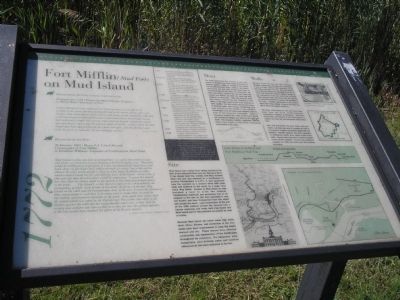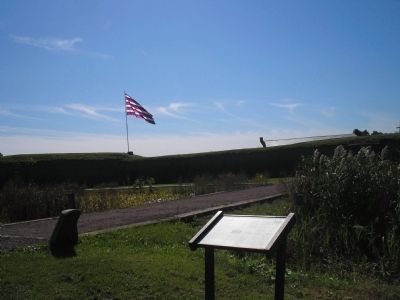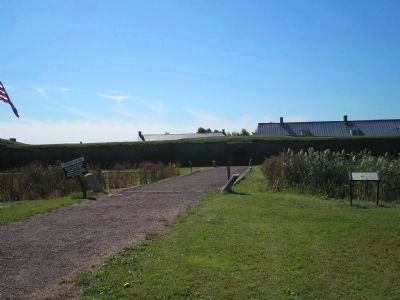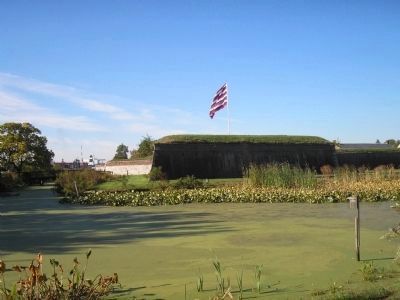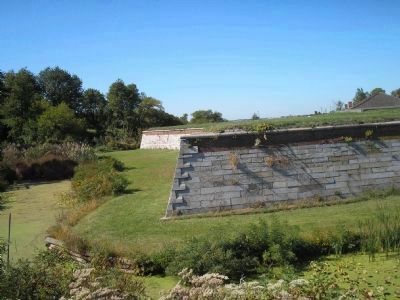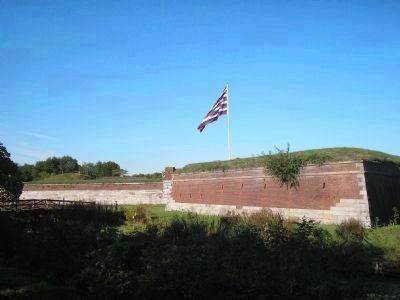Fort Mifflin in Philadelphia in Philadelphia County, Pennsylvania — The American Northeast (Mid-Atlantic)
Fort Mifflin (Mud Fort) on Mud Island
1772
Report from the Fort (during construction)
25 September 1794 . Pierre Charles L’Enfant, Engineer to Henry Knox, Secretary of War
A place destitute of every comfort for the hands [workmen]; lay open to all accidents of the season [and was] uncommonly bad in the months of June, July and August, when extraordinary freshes [floods] and storms greatly injured the work and caused an increase of labor which could not have been foreseen nor avoided, having had successively to repair the extensive bank round the Island, to build new sluices, open new drains, and dig over and over all ditches, without which the whole Island must have been overflowed; the whole work upset, and the laboring hands with the garrison, reduced to the most unhappy situation.
Report from the Fort
21 January 1802 . Major J.J. Ulrich Rivardi, Commander of Fort Mifflin
to Jonathan Williams, Inspector of Fortifications, West Point
Mud Island is about one mile in circumference 740 yards from north to south and about 300 from east to west, forming a kind of irregular oval. The whole would be overflowed at high water, if it was not protected all round by a solid bank about six feet high which admits through two sluices (one to the east the other to the west) water enough to clean in a few hours the ditches or rather trenches drawn round the fort and different parts of the Island. In two tides, if they were left open, the whole place would be underwater. I cannot but remark here that these two sluices ought in my opinion to have been placed much nearer to the works … The Island is so low that it is more or less commanded by the surrounding grounds, State Island on the north, the Jerseys on the east, Hog Island on the south and the Pennsylvania shore in the west, however the distance of these several points is such that if any enemy were to occupy them, he could do but trifling and uncertain execution on the works, being much more remote than the station which was taken by the Vigilant last War, whose shot where it fell thickest against the walls left but inconsiderable impression so that, had the western and southern sides been walled in as they are now, the gallant defenders of the Fort would have rendered the efforts of the British abortive.
Site
Mud Island was created from silting caused by the flow of the Schuylkill River into the Delaware River. It has always been low, marshy, and likely to flood. When the site was selected for a fortification to protect Philadelphia in 1771, it was separated from the mainland by a channel about 500 yards wide and buffered to the south by a larger land mass, Hog Island. Access to Mud Island by road included a boat to cross the channel. Construction materials and provisions had to be shipped to the site by the river (provided it was not frozen) and then transported from the wharf and across the moat. Land reclamation at the end of the 19th century turned the channel into a narrow waterway and made both Hog Island and Mud Island part of the mainland accessible by road or Trolley.
Because Mud Island sits below mean high water level, dikes, ditches, and protection of the river banks have been requirements to keep the island drained and dry. These factors have affected construction and maintenance of the fortification throughout its existence. The dampness, wind, mosquitoes, poor drinking water, and isolation influenced all who were stationed at the fort.
Moat
The moat around the fort served not only as a system of drainage and water supply, but also as a defense against sieges or mining by the enemy. The pre-Revolutionary moat, called a “wet ditch,” was narrow and only went around three sides. In reconstructing the fort after the Revolution, the moat was dug to encircle the new fort walls and widened to thirty feet. Mud dug from the ditch was always recycled into the ramparts or river banks to fill in holes made by the river, muskrats or other wildlife. The river water was the only source of drinking water, and a clean, free-flowing moat was critical to the health
of the soldiers. Drawbridges over the moat were originally used at each of the three fort entrances. Today a causeway crosses the moat at the north portal and permanent bridges are used on the east and south. The seasons, wildlife, vegetation, and the water flow create a constantly fluctuating environment in the moat.
Walls
Because of the low and wet land, standard European engineering techniques for construction in wet soil were used by John Montrésor for the first stone walls built in 1772. The same practice was continued during the reconstruction of the fort in 1778, and furthered by Pierre Charles L’Enfant for the completion of the new walls from 1791-98. Piles (actually trees) were dropped into the moat and an interlaced platform of planks were fastened to the ends. Constant submersion of the wood in water kept it from rotting. Stones for the walls was laid on top of the wooden platforms.
The stone walls along the east and south sides stem from the 1772 pre-Revolutionary construction designed by Montrésor. They were essentially free-standing with buttresses for support and were the only permanent walls at that time.
After the Revolution the early stone wall was rebuilt, and brick was used to complete the fort as an enclosed, irregular star-shaped design with two bastions. Earthen ramparts and brick casemates or bombproof vaults were added inside
these walls. Cannon were mounted on wooden carriages on the earthen ramparts. The fort was considered completed by 1798, but much work still remained to be done.
Erected by Fort Mifflin Historic Site.
Topics. This historical marker is listed in these topic lists: Forts and Castles • Notable Places • War, US Revolutionary. A significant historical date for this entry is January 21, 1802.
Location. 39° 52.553′ N, 75° 12.761′ W. Marker is in Philadelphia, Pennsylvania, in Philadelphia County. It is in Fort Mifflin. Marker is on W Fort Mifflin Road, on the right when traveling east. Marker is along the walking tour of Fort Mifflin. Touch for map. Marker is at or near this postal address: 6400 Hog Island Rd, Philadelphia PA 19153, United States of America. Touch for directions.
Other nearby markers. At least 8 other markers are within walking distance of this marker. Soldiers’ Barracks (within shouting distance of this marker); Quartermaster’s Store (within shouting distance of this marker); From Marsh to Solid Ground (within shouting distance of this marker); Officers’ Quarters (within shouting distance of this marker); Casemates or Bombproofs (within shouting distance of this marker); Arsenal (within shouting distance of this marker); Artillery (within shouting distance of this marker); Fort Mifflin (within shouting distance of this marker). Touch for a list and map of all markers in Philadelphia.
